The art of food presentation can enhance impression of dishes
A visually appealing art on a plate reflects the personality of the chef. Food presentation is the art of preparing, cooking and then presenting the food in the most creative ways. When dining at a restaurant apart from the ambience, taste and smell, diners do look for a good presentation of the dishes that are served. There is a certain charm in how the food is plated, what we call ‘food plating’. A creative food plating adds to the visual treat and the positive reviews for a great dining experience.
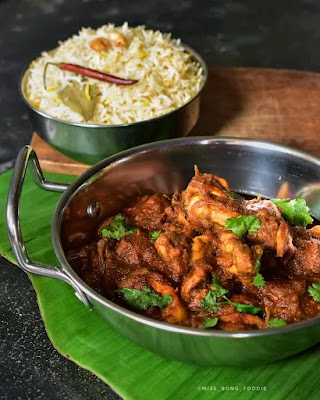 |
| A good plating enrichens the quality of the dish. |
Importance of food presentation in restaurants and cafes
For an outstanding restaurant review, what diners look forward to is much more than the ambience, smell and taste. It’s also about the visual presentation that adds to the feat of the restaurant. A decent food presentation not only appeals to a customer but also creates a good impression about the restaurant. Furthermore, in the age of social media, food presentation with quality food photography creates a post capable of drawing in more customers.
The aesthetic view of the food gives an overall idea of how the food will taste and feel. Customers tend to believe that dishes that are plated and served well are of high quality and takes a lot of effort to make it.
If we are dining in at a restaurant that serves the dishes, consider it cooked by the same chef. Yet, one is garnished with spices, with proper plating, following the thumb rule of food presentation, and has maintained proper cleanliness, making the dish attractive while the other one has just been poured or put on a plate or bowl. Which one would you prefer? Obviously, it’s the one with good plating. It boasts a customer’s perception.
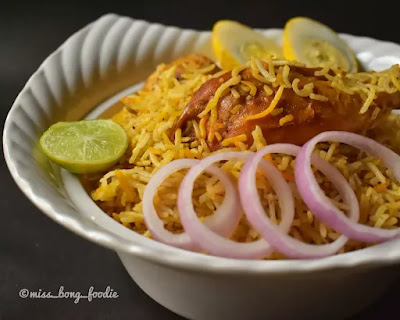 |
| Biryani presented along with onion slices and lemon |
A dish when presented in a good way is more likely to reach social media. When a customer loves the food and its appearance, the photos are uploaded on a media platform, hence giving exposure to the restaurant and the dish as well. This adds to the free marketing for the product or service and draws in more customers. Next, the food presentation says about the quality of the restaurant. It reflects the hygiene and sanitization of the restaurant.
When food is plated with sauces, garnishes, side dips it increases the quality of the food and adds a unique flavour and texture to the dish. Food that appears alluring on social media tends to allure the customer as well to visit the restaurant and enjoy the dish.
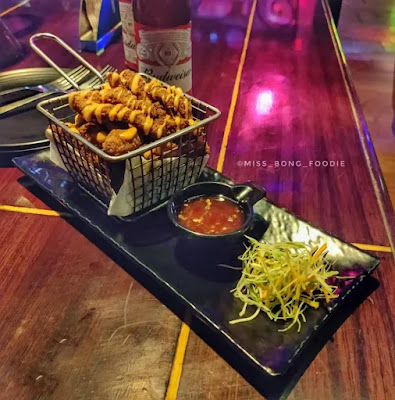 |
| The appetizer is presented with side dips, salad and garnished with peri peri sauce over the main item |
Food plating is an art that allows chefs with innovative minds to come up with exciting ideas and new inventions.
‘Food Plating’ has a science behind it!
The shape, size and colour of the plate depending on the dish. Also, there are certain rules which determine where to place what on your plate, to design your dish. Proper garnishing is necessary to give a finishing touch to the artwork.
Art of Plating Explained
Know the four basic elements of a plate:
A plate should be perfectly planned to balance the taste, texture, colours and ingredients. The plated dish must show a sense of composition and balance between the things on the plate. With an accurate amount, fresh ingredients, perfectly chopped, the plating should be done. The following are the elements:
The main item:
It should be on focus when placed on the plate. Whether it’s a chicken breast or a steak or cheesecake or anything, it must not look overcook or burnt or raw.
Supporting item:
The main item is supported by other ingredients like vegetables. In the case of a steak, the supporting item is sautéed vegetables, mashed potato and a poached egg. It must be ensured that the supporting item should be less in quantity than the main item. It should not defocus the main item. The supporting item contributes to the overall appearance, flavour and taste of the dish.
Sauces or side dips:
Sauces or dips of correct texture and thickness tie the elements together and gives a flavorful punch to the dish.
Garnishes:
Spices or chopped leafy vegetables to add a finishing touch to the dish is extremely important. Sprinkling black pepper or garnishing with chopped mint or coriander leaves gives a charm to the dish and makes it attractive.
 |
| A complete plate of steak with the main ingredient, supporting items and sides. |
How to select the right plate?
Plating food also includes selecting the right plate for your dish. Plates and bowls come in different shapes, sizes and colours. Serving vessels often act as an important part.
Styles:
The theme of the restaurant and the food which is served, decides the style of the plate, bowl and cups. If the food is traditional, it is more likely to be served in traditional utensils. While new inventions and dishes of modern origin should be put in a plate of modern cutlery ware. The cuisine that the restaurant serves also influences the style. Such as Chinese restaurants like ‘Chowman’ and ‘Momo I Am’ serve food in Chinese bowls and use the Chinese way of presentation. Whereas Oudh 1590 serves Mughal cuisine on steel plates. Food is served in different shapes of plates and bowls. Depending on the type of food.
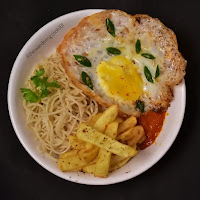 |
| A Chinese food is served in a Chinese bowl |
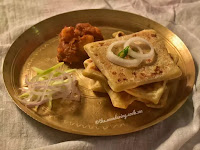 |
| Mughlai Paratha, a Mughal dish is served in a brass vessel |
Serving Sizes:
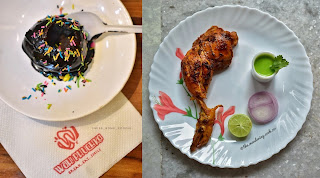 |
| Small plate serving vs large plate serving. |
Restaurants use different plates for starters, main course, side dishes, and desserts. They often prefer designable plates for serving starters. The main course is served in plates that look different from those of the starters. Yet, when serving a particular dish, some restaurants do like serving in a plate of large size, where they can put the sides and the garnishes and the dips.
Colors:
The colour and the texture of the food decides the colour of the plate. Food that is light coloured is often placed on dark or black plates. Matte textured plates are trendy. The food and plate colour stay in contrast, hence they are placed accordingly. Warm grey, Brown and tan colour plates are used as well.
What are the tools used?
Tools such as squeeze bottles, spatulas, spoons, forks, brushes, tongs, moulds, tweezers and so on are used to design the elements on a plate.
How to place the elements on a plate?
Look for the focal point. A focal point is where the diner will first look or get attracted to. Using the rule of the third might help while placing the elements. Think of imaginary two vertical and two horizontal lines crossing each other. The intersecting points are the focal points. Put your elements on the focal points. Avoid the rim of the plate.

The way you use edible flowers and microgreens is genius. Simple touches, but they add so much elegance For further details, please visit our official website https://www.srimayyiacaterers.co.in/ or contact us at +91 98450 38235 / +91 98454 97222.
ReplyDeletePost a Comment